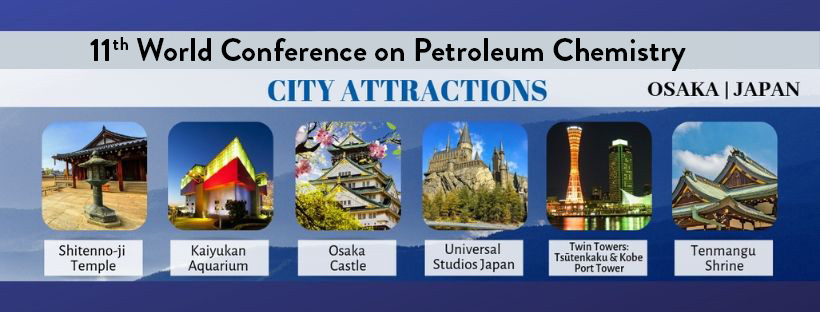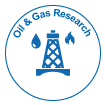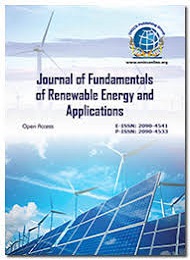Theme: Current Trends & Challenges in Petroleum Exploration & Production
Petrochemistry 2020
Conferenceseries LLC Ltd and its subsidiaries including iMedPub Ltd and Conference Series Organise 3000+ Conferences across USA, Europe & Asia with support from 1000 more scientific societies and Publishes 700+ Open Access Journals which contains over 50000 eminent personalities, reputed scientists as editorial board members.
Conferenceseries LLC Ltd is an amalgamation of Open Access Publications and worldwide international science conferences and events. Established in the year 2007 with the sole aim of making the information on Sciences and technology "Open Access", Conferenceseries LLC Ltd publishes scholarly journals in all aspects of Science, Engineering, Management and Technology journals. Conferenceseries LLC Ltd has been instrumental in taking the knowledge on Science & technology to the doorsteps of ordinary men and women. Research Scholars, Students, Libraries, Educational Institutions, Research centers and the industry are main stakeholders that benefitted greatly from this knowledge dissemination. Conferenceseries LLC Ltd also organizes 3000+ International conferences across the globe, where knowledge transfer takes place through debates, round table discussions, poster presentations, workshops, symposia and exhibitions.
Track 1: Geology & Exploration
Geological prospecting and exploration for oil and gas is a set of industrial and R&D activities for geological study of subsurface resources, identification of promising areas, and discovery of fields, their evaluation and pre-development. The final objective of geological prospecting is preparation of subsurface resources. The main principle of geological prospecting is the comprehensive geological study of subsurface resources when along with oil and gas exploration all associated components (petroleum gas and its composition, sulphur, rare metals, etc.), possibility and practicality of their production or utilization are investigated; hydrogeological, coal mining, engineering, geological and other studies are performed; natural, climatic, socioeconomic, geological engineering and economic indicator and their changes caused by future field development are analysed.
Keywords: Petrochemistry Conference, Oil & Gas Conference, Chemistry Conference, Chemical engineering Conference, Oil Conference, Petrochemistry Conference Japan, Oil & Gas Conference Japan, Oil Conference Japan, Petrochemistry Conference 2020, Oil & Gas Conference 2020, Energy Processing Conferences, Petroleum Events 2020, Engineering Conference, Japan Conference, Energy Processing Conferences, Asia Pacific Conferences, Pipeline Transportation Conferences, Simulation Modelling Conferences
Related Societies: California Independent Petroleum Association (CIPA), American Association of Petroleum Geologists, South East Asia Petroleum Exploration Society, The Petroleum Exploration Society of Great Britain, Malaysian Petrochemicals Association, Petroleum Technology Alliance Canada.
Track 2: Reservoir Characterisation
In the oil and gas engineering industry, reservoir modelling involves the construction of a computer model of a petroleum reservoir, for the purposes of improving estimation of reserves and making decisions regarding the development of the field.
A reservoir model represents the physical space of the reservoir by an array of discrete cells, delineated by a grid which may be regular or irregular. The array of cells is usually three-dimensional, although 1D and 2D models are sometimes used. Values for attributes such as porosity, permeability and water quality are associated with each cell. The value of each attribute is implicitly deemed to apply uniformly throughout the volume of the reservoir represented by the cell.
Keywords: Petrochemistry Conference, Oil & Gas Conference, Chemistry Conference, Chemical engineering Conference, Oil Conference, Petrochemistry Conference Japan, Oil & Gas Conference Japan, Oil Conference Japan, Petrochemistry Conference 2020, Oil & Gas Conference 2020, Energy Processing Conferences, Petroleum Events 2020, Engineering Conference, Japan Conference, Energy Processing Conferences, Asia Pacific Conferences, Pipeline Transportation Conferences, Simulation Modelling Conferences
Related Societies: California Independent Petroleum Association (CIPA), American Association of Petroleum Geologists, South East Asia Petroleum Exploration Society, The Petroleum Exploration Society of Great Britain, Malaysian Petrochemicals Association, Petroleum Technology Alliance Canada
Track 3: Drilling & Well Operations
One of the remarkable accomplishments of the petroleum engineering technology has been the development of technology that allows for drilling wells offshore to access additional energy resources. The basic offshore wellbore construction process is not significantly different than the rotary drilling process used for land based drilling. The main differences are the type drilling rig and modified methods used to carry out the operations in a more complex situation. For offshore drilling a Mechanical Properties of stable offshore platform or floating vessel from which to drill must be provided. These range from permanent offshore fixed or floating platforms to temporary bottom-supported or floating drilling vessels. Drilling offshore began near the turn of the 20th century when shallow water fixed platforms were used to access offshore reservoirs. But offshore drilling and production did not really develop to be widely viable until after 1947 when the first offshore well was drilled at a location completely out of site of land. Since then, offshore production, particularly in the US Gulf of Mexico, has resulted in the discovery and delivery of a significant contribution to the total US bioenergy production, with about 35% of crude oil production in the US coming from offshore developments. Offshore drilling has considerably higher costs than for land-based drilling, depending on water depth and well complexity, which requires a larger volume of hydrocarbons reservoir that can be economically justified.
Keywords: Petrochemistry Conference, Oil & Gas Conference, Chemistry Conference, Chemical engineering Conference, Oil Conference, Petrochemistry Conference Japan, Oil & Gas Conference Japan, Oil Conference Japan, Petrochemistry Conference 2020, Oil & Gas Conference 2020, Energy Processing Conferences, Petroleum Events 2020, Engineering Conference, Japan Conference, Energy Processing Conferences, Asia Pacific Conferences, Pipeline Transportation Conferences, Simulation Modelling Conferences
Related Societies: California Independent Petroleum Association (CIPA), American Association of Petroleum Geologists, South East Asia Petroleum Exploration Society, The Petroleum Exploration Society of Great Britain, Malaysian Petrochemicals Association, Petroleum Technology Alliance Canada
Track 4: Process Technology
Petroleum refining processes are the chemical engineering processes and other facilities used in petroleum refineries (also referred to as oil refineries) to transform crude oil into useful products such as liquefied petroleum gas (LPG), gasoline or petrol, kerosene, jet fuel, diesel oil and fuel oils.
Petroleum refineries are very large industrial complexes that involve many different processing units and auxiliary facilities such as utility units and storage tanks. Each refinery has its own unique arrangement and combination of refining processes largely determined by the refinery location, desired products and economic considerations. There are most probably no two refineries that are identical in every respect. Some modern petroleum refineries process as much as 800,000 to 900,000 barrels (127,000 to 143,000 cubic meters) per day of crude oil.
Keywords: Petrochemistry Conference, Oil & Gas Conference, Chemistry Conference, Chemical engineering Conference, Oil Conference, Petrochemistry Conference Japan, Oil & Gas Conference Japan, Oil Conference Japan, Petrochemistry Conference 2020, Oil & Gas Conference 2020, Energy Processing Conferences, Petroleum Events 2020, Engineering Conference, Japan Conference, Energy Processing Conferences, Asia Pacific Conferences, Pipeline Transportation Conferences, Simulation Modelling Conferences
Related Societies: California Independent Petroleum Association (CIPA), American Association of Petroleum Geologists, South East Asia Petroleum Exploration Society, The Petroleum Exploration Society of Great Britain, Malaysian Petrochemicals Association, Petroleum Technology Alliance Canada
Track 5: Chemical Applications
Petroleum Chemistry is made of a mixture of different hydrocarbons. The most prolific hydrocarbons found in the chemistry of petroleum are alkanes, these are also sometimes knows as branched or linear hydrocarbons. A significant percentage of the remaining chemical compound is the made up of aromatic hydrocarbons and cycloalkanes. Additionally petroleum chemistry contains several more complex hydrocarbons such as asphaltenes. Each geographical location and hence oil field will produce a raw petroleum with a different combination of molecules depending upon the overall percentage of each hydrocarbon it contains, this directly affects the colouration and viscosity of the petroleum chemistry. The primary form of hydrocarbons in the chemistry of petroleum is the alkanes, which are also often named paraffin’s. These are termed saturated hydrocarbons and the exhibit either branched or straight molecule chains.
Keywords: Petrochemistry Conference, Oil & Gas Conference, Chemistry Conference, Chemical engineering Conference, Oil Conference, Petrochemistry Conference Japan, Oil & Gas Conference Japan, Oil Conference Japan, Petrochemistry Conference 2020, Oil & Gas Conference 2020, Energy Processing Conferences, Petroleum Events 2020, Engineering Conference, Japan Conference, Energy Processing Conferences, Asia Pacific Conferences, Pipeline Transportation Conferences, Simulation Modelling Conferences
Related Societies: California Independent Petroleum Association (CIPA), American Association of Petroleum Geologists, South East Asia Petroleum Exploration Society, The Petroleum Exploration Society of Great Britain, Malaysian Petrochemicals Association, Petroleum Technology Alliance Canada
Track 6: Enhanced Oil & Gas Recovery
Enhanced oil recovery (abbreviated EOR) is the implementation of various techniques for increasing the amount of crude oil that can be extracted from an oil field. Enhanced oil recovery is also called improved oil recovery or tertiary recovery (as opposed to primary and secondary recovery). According to the US Department of Energy, there are three primary techniques for EOR: thermal recovery, gas injection, and chemical injection. Sometimes the term quaternary recovery is used to refer to more advanced, speculative, EOR techniques. Using EOR, 30 to 60 percent, or more, of the reservoir's original oil can be extracted, compared with 20 to 40 percent using primary and secondary recovery.
There are three primary techniques of EOR: gas injection, thermal injection, and chemical injection. Gas injection, which uses gases such as natural gas, nitrogen, or carbon dioxide (CO2), accounts for nearly 60 percent of EOR production in the United States. Thermal power injection, which involves the introduction of heat, accounts for 40 percent of EOR production in the United States, with most of it occurring in California. Chemical information of injection, which can involve the use of long-chained molecules called polymers to increase the effectiveness of water floods, accounts for about one percent of EOR production in the United States. In 2013, a technique called Plasma-Pulse chemical technology was introduced into the United States from Russia. This technique can result in another 50 percent of improvement in existing well production.
Keywords: Petrochemistry Conference, Oil & Gas Conference, Chemistry Conference, Chemical engineering Conference, Oil Conference, Petrochemistry Conference Japan, Oil & Gas Conference Japan, Oil Conference Japan, Petrochemistry Conference 2020, Oil & Gas Conference 2020, Energy Processing Conferences, Petroleum Events 2020, Engineering Conference, Japan Conference, Energy Processing Conferences, Asia Pacific Conferences, Pipeline Transportation Conferences, Simulation Modelling Conferences
Related Societies: California Independent Petroleum Association (CIPA), American Association of Petroleum Geologists, South East Asia Petroleum Exploration Society, The Petroleum Exploration Society of Great Britain, Malaysian Petrochemicals Association, Petroleum Technology Alliance Canada
Track 7: Pipelines & Transportation
Pipeline transport is the transportation of goods or material through a pipe. The best data, in 2014, gives a total of slightly less than 3.5 million km of pipeline in 120 countries of the world. The United States had 65%, Russia had 8%, and Canada had 3%, thus 75% of all pipelines were in three countries.
Pipeline and Gas Journal’s worldwide survey figures indicate that 118,623 miles (190,905 km) of pipelines are planned and under construction. Of these, 88,976 miles (143,193 km) represent projects in the planning and design phase; 29,647 miles (47,712 km) reflect pipelines in various stages of construction. Liquids and gases are transported in pipelines and any chemically stable substance can be sent through a pipeline. Pipelines exist for the transport of crude and refined petroleum, fuels - such as oil, natural gas and biofuels - and other fluids including sewage, slurry, water, and beer. Pipelines are useful for transporting water for drinking or irrigation over long distances when it needs to move over hills, or where canals or channels are poor choices due to considerations of evaporation, pollution, or environmental impact. Pneumatic tubes using compressed air can be used to transport solid capsules.
Oil pipelines are made from steel or plastic tubes which are usually buried. The oil is moved through the pipelines by pump stations along the pipeline. Natural gas (and similar gaseous fuels) are lightly pressurised into liquids known as Natural Gas Liquids (NGLs). Natural gas pipelines are constructed of carbon steel. Highly toxic ammonia is theoretically the most dangerous substance to be transported through long-distance pipelines, but accidents have been rare. Hydrogen pipeline transport is the transportation of hydrogen through a pipe. District heating or teleheating systems use a network of insulated pipes which transport heated water, pressurized hot water or sometimes steam to the customer.
Pipelines conveying flammable or explosive material, such as natural gas or oil, pose special safety concerns and there have been various accidents. Pipelines can be the target of vandalism, sabotage, or even terrorist attacks. In war, pipelines are often the target of military attacks.
Keywords: Petrochemistry Conference, Oil & Gas Conference, Chemistry Conference, Chemical engineering Conference, Oil Conference, Petrochemistry Conference Japan, Oil & Gas Conference Japan, Oil Conference Japan, Petrochemistry Conference 2020, Oil & Gas Conference 2020, Energy Processing Conferences, Petroleum Events 2020, Engineering Conference, Japan Conference, Energy Processing Conferences, Asia Pacific Conferences, Pipeline Transportation Conferences, Simulation Modelling Conferences
Related Societies: California Independent Petroleum Association (CIPA), American Association of Petroleum Geologists, South East Asia Petroleum Exploration Society, The Petroleum Exploration Society of Great Britain, Malaysian Petrochemicals Association, Petroleum Technology Alliance Canada
Track 8: Onshore/Offshore Support
Offshore drilling is a mechanical process where a wellbore is drilled below the seabed. It is typically carried out in order to explore for and subsequently extract petroleum which lies in rock formations beneath the seabed. Most commonly, the term is used to describe drilling activities on the continental shelf, though the term can also be applied to drilling in lakes, inshore waters and inland seas.
Offshore drilling presents environmental challenges, both from the produced hydrocarbons and the materials used during the drilling operation. Controversies include the on-going US offshore drilling debate.
There are many different types of facilities from which offshore drilling operations take place. These include bottom founded drilling rigs (jackup barges and swamp barges), combined drilling and production facilities either bottom founded or floating platforms, and deep water mobile offshore drilling units (MODU) including semi-submersibles and drillships. These are capable of operating in water depths up to 3,000 metres (9,800 ft.). In shallower waters the mobile units are anchored to the seabed, however in deeper water (more than 1,500 metres (4,900 ft.) the semisubmersibles or drillships are maintained at the required drilling location using dynamic positioning.
Based largely on development of the reserves of the North West Shelf and other onshore hydrocarbon basins, the industry extracts crude oil, condensate and natural gas from petroleum reservoirs deep beneath the Earth's surface. A large plant located at Withnell Bay near Dampier, produces liquefied natural gas (LNG) for export to Asian customers. Crude oil and most petroleum liquids are exported, and Australia's largest petroleum refinery at Kwinana in WA's south-west, produces petrol and diesel for local consumption. Natural gas is processed at plants located on islands off the WA coast and onshore, and then transported by pipelines to gas users throughout the state.
Keywords: Petrochemistry Conference, Oil & Gas Conference, Chemistry Conference, Chemical engineering Conference, Oil Conference, Petrochemistry Conference Japan, Oil & Gas Conference Japan, Oil Conference Japan, Petrochemistry Conference 2020, Oil & Gas Conference 2020, Energy Processing Conferences, Petroleum Events 2020, Engineering Conference, Japan Conference, Energy Processing Conferences, Asia Pacific Conferences, Pipeline Transportation Conferences, Simulation Modelling Conferences
Related Societies: California Independent Petroleum Association (CIPA), American Association of Petroleum Geologists, South East Asia Petroleum Exploration Society, The Petroleum Exploration Society of Great Britain, Malaysian Petrochemicals Association, Petroleum Technology Alliance Canada
Track 9: Upstream/Downstream & Midstream Integration
The oil and gas engineering industry is usually divided into three major sectors: upstream, midstream and downstream. The upstream oil sector is also commonly known as the exploration and production (E&P) sector.
The upstream sector includes the searching for potential underground or underwater crude oil and natural gas fields, drilling of exploratory wells, and subsequently drilling and operating the wells that recover and bring the crude oil and/or raw natural gas to the surface. There has been a significant shift toward including unconventional gas as a part of the upstream sector, and corresponding developments in liquefied natural gas (LNG) processing and transport.
The oil and gas industry is usually divided into three major sectors: upstream, midstream and downstream. The downstream sector commonly refers to the refining of petroleum crude oil and the processing and purifying of raw natural gas, as well as the marketing and distribution of products derived from crude oil and natural gas. The downstream sector touches consumers through products such as gasoline or petrol, kerosene, jet fuel, diesel oil, heating oil, fuel oils, lubricants, waxes, asphalt, natural gas, and liquefied petroleum gas (LPG) as well as hundreds of petrochemicals.
Midstream operations are often included in the downstream category and considered to be a part of the downstream sector. The petroleum industry is usually divided into three major components: upstream, midstream and downstream. The midstream sector involves the transportation (by pipeline, rail, barge, oil tanker or truck), storage, and wholesale marketing of crude or refined petroleum products. Pipelines and other transport systems can be used to move crude oil from production sites to refineries and deliver the various refined products to downstream distributors. Natural gas pipeline networks aggregate gas from natural gas purification plants and deliver it to downstream customers, such as local utilities.
Keywords: Petrochemistry Conference, Oil & Gas Conference, Chemistry Conference, Chemical engineering Conference, Oil Conference, Petrochemistry Conference Japan, Oil & Gas Conference Japan, Oil Conference Japan, Petrochemistry Conference 2020, Oil & Gas Conference 2020, Energy Processing Conferences, Petroleum Events 2020, Engineering Conference, Japan Conference, Energy Processing Conferences, Asia Pacific Conferences, Pipeline Transportation Conferences, Simulation Modelling Conferences
Related Societies: California Independent Petroleum Association (CIPA), American Association of Petroleum Geologists, South East Asia Petroleum Exploration Society, The Petroleum Exploration Society of Great Britain, Malaysian Petrochemicals Association, Petroleum Technology Alliance Canada
Track 10: Unconventional Resources
Unconventional oil is petroleum produced or extracted using techniques other than the conventional (oil well) method. Oil industries and governments across the globe are investing in unconventional oil sources due to the increasing scarcity of conventional oil reserves.
According to the International Energy Agency's (IEA) World Energy Outlook 2001 unconventional oil included "oil shale’s, oil sands-based synthetic crudes and derivative products, (heavy oil, Orimulsion), coal-based liquid supplies, biomass-based liquid supplies, gas to liquid (GTL) - liquids arising from chemical processing of gas."
In the IEA's World Energy Outlook 2011 report, "unconventional oil include extra-heavy oil, natural bitumen (oil sands), kerosene oil, liquids and gases arising from chemical processing of natural gas (GTL), coal-to-liquids (CTL) and additives."
Keywords: Petrochemistry Conference, Oil & Gas Conference, Chemistry Conference, Chemical engineering Conference, Oil Conference, Petrochemistry Conference Japan, Oil & Gas Conference Japan, Oil Conference Japan, Petrochemistry Conference 2020, Oil & Gas Conference 2020, Energy Processing Conferences, Petroleum Events 2020, Engineering Conference, Japan Conference, Energy Processing Conferences, Asia Pacific Conferences, Pipeline Transportation Conferences, Simulation Modelling Conferences
Related Societies: California Independent Petroleum Association (CIPA), American Association of Petroleum Geologists, South East Asia Petroleum Exploration Society, The Petroleum Exploration Society of Great Britain, Malaysian Petrochemicals Association, Petroleum Technology Alliance Canada
Track 11: Gas Supply & Gas Technology
Industrial gases are a group of gases that are specifically manufactured for use in a wide range of industries, which include oil and gas, petro-chemistry, chemicals, power, mining, steelmaking, metals, environmental pollution, medicine, pharmaceuticals, biotechnology, food, water, fertilizers, nuclear power, electronics and aerospace. Their production is a part of the wider chemical Industry (where industrial gases are often seen as "speciality chemicals").
The principal gases provided are nitrogen, oxygen, carbon dioxide, argon, hydrogen, helium and acetylene; although a huge variety of natural gases and mixtures are available in gas cylinders. The industry producing these gases is known as the industrial gases industry, which is seen as also encompassing the supply of equipment and technology to produce and use the gases.
Whilst most industrial gas is usually only sold to other industrial enterprises; retail sales of gas cylinders and associated equipment to tradesmen and the general public are available through gas local agents and typically includes products such as balloon helium , dispensing gases for beer kegs, welding gases and welding equipment, LPG and medical oxygen.
Very small scale gas supply is not confined to just the industrial gas companies. A wide variety of hand-carried small gas containers, which may be called cylinders, bottles, cartridges, capsules or canisters are available to supply LPG, butane, propane, carbon dioxide or nitrous oxide. Examples are whippets, powerlets, camping and soda stream.
Keywords: Petrochemistry Conference, Oil & Gas Conference, Chemistry Conference, Chemical engineering Conference, Oil Conference, Petrochemistry Conference Japan, Oil & Gas Conference Japan, Oil Conference Japan, Petrochemistry Conference 2020, Oil & Gas Conference 2020, Energy Processing Conferences, Petroleum Events 2020, Engineering Conference, Japan Conference, Energy Processing Conferences, Asia Pacific Conferences, Pipeline Transportation Conferences, Simulation Modelling Conferences
Related Societies: California Independent Petroleum Association (CIPA), American Association of Petroleum Geologists, South East Asia Petroleum Exploration Society, The Petroleum Exploration Society of Great Britain, Malaysian Petrochemicals Association, Petroleum Technology Alliance Canada
Track 12: Sustainable Energy
Sustainable energy is the form of energy obtained from non-exhaustible resources, such that the provision of this form of energy serves the needs of the present without compromising the ability of future generations to meet their needs.
Technologies that promote sustainable energy include renewable energy sources, such as hydroelectricity, solar energy, wind energy, wave power, geothermal energy, bioenergy, tidal power and also technologies designed to improve energy efficiency. Costs have fallen dramatically in recent years, and continue to fall. Most of these technologies are either economically competitive or close to being so. Increasingly, effective government policies support investor confidence and these markets are expanding. Considerable progress is being made in the energy transition from fossil fuels to ecologically sustainable systems, to the point where many studies support 100% renewable energy. Renewable energy is derived from natural processes. It has various forms and can be derived directly from the sun, or from heat generated deep within the earth. There are electricity and heat energy generated from the renewable energy resources.
Keywords: Petrochemistry Conference, Oil & Gas Conference, Chemistry Conference, Chemical engineering Conference, Oil Conference, Petrochemistry Conference Japan, Oil & Gas Conference Japan, Oil Conference Japan, Petrochemistry Conference 2020, Oil & Gas Conference 2020, Energy Processing Conferences, Petroleum Events 2020, Engineering Conference, Japan Conference, Energy Processing Conferences, Asia Pacific Conferences, Pipeline Transportation Conferences, Simulation Modelling Conferences
Related Societies: California Independent Petroleum Association (CIPA), American Association of Petroleum Geologists, South East Asia Petroleum Exploration Society, The Petroleum Exploration Society of Great Britain, Malaysian Petrochemicals Association, Petroleum Technology Alliance Canada
Track 13: Health, Safety, and Environment
Oil industry holds a major potential of hazards for the environment, and may impact it at different levels: air, water, soil, and consequently all living beings on our planet. Within this context, the most widespread and dangerous consequence of oil and gas industry activities is pollution. Pollution is associated with virtually all activities throughout all stages of oil and gas production, from exploratory activities to Refining Crude. Wastewaters, gas emissions, solid waste and aerosols generated during drilling, production, refining (responsible for the most pollution) and transportation amount to over 800 different chemicals, among which, of course, prevail oil and petroleum products. Other environmental impacts include intensification of the greenhouse effect, acid rain, poorer water quality, groundwater contamination, among others. The oil and gas industry may also contribute to biodiversity and conservation loss as well as to the destruction of ecosystems that, in some cases, may be unique.
Keywords: Petrochemistry Conference, Oil & Gas Conference, Chemistry Conference, Chemical engineering Conference, Oil Conference, Petrochemistry Conference Japan, Oil & Gas Conference Japan, Oil Conference Japan, Petrochemistry Conference 2020, Oil & Gas Conference 2020, Energy Processing Conferences, Petroleum Events 2020, Engineering Conference, Japan Conference, Energy Processing Conferences, Asia Pacific Conferences, Pipeline Transportation Conferences, Simulation Modelling Conferences
Related Societies: California Independent Petroleum Association (CIPA), American Association of Petroleum Geologists, South East Asia Petroleum Exploration Society, The Petroleum Exploration Society of Great Britain, Malaysian Petrochemicals Association, Petroleum Technology Alliance Canada
Track 14: Renewable Energy and Feedstock
Renewable energy is energy generated from natural resources such as sunlight, wind, rain, tides and geothermal heat which are renewable. Renewable energy technologies range from solar power, wind power, hydroelectricity/micro hydro, biomass and biofuels for transportation. And a feedstock is defined as any renewable, biological material that can be used directly as a fuel, or converted to another form of fuel or energy product. Biomass feedstock’s are the plant and algal materials used to derive fuels like ethanol, butanol, biodiesel, and other hydrocarbon fuels.
Keywords: Petrochemistry Conference, Oil & Gas Conference, Chemistry Conference, Chemical engineering Conference, Oil Conference, Petrochemistry Conference Japan, Oil & Gas Conference Japan, Oil Conference Japan, Petrochemistry Conference 2020, Oil & Gas Conference 2020, Energy Processing Conferences, Petroleum Events 2020, Engineering Conference, Japan Conference, Energy Processing Conferences, Asia Pacific Conferences, Pipeline Transportation Conferences, Simulation Modelling Conferences
Related Societies: California Independent Petroleum Association (CIPA), American Association of Petroleum Geologists, South East Asia Petroleum Exploration Society, The Petroleum Exploration Society of Great Britain, Malaysian Petrochemicals Association, Petroleum Technology Alliance Canada
Track 15: Coal and Natural Gas
Crude oil, coal and natural gas formed from the prehistoric matter of plants, animals, zooplankton and other life that was buried sometimes miles deep inside the Earth and subjected to high temperatures and high pressure over millions of years. These three so-called fossil fuels include a wide assortment of carbon-based substances.
Humans have known about petroleum, or crude oil, from centuries, but the substance wasn’t considered terribly interesting until the mid-1800s, when it was distilled into kerosene and found to be a good, cheap alternative to burning whale oil in oil lamps. At that time, only the wealthiest could afford whale oil, which was preferred over candles or animal fats. Americans and others worldwide quickly adopted petroleum and learned to make an unending stream of useful products from it. Simultaneously, a worldwide obsession with striking oil was born.
In 1885 Robert Bunsen invented the Bunsen burner, which mixes gas with air to produce a steady flame for heat or cooking. Widespread household use of natural gas waited until the mid-twentieth century, when thousands of miles of natural gas pipelines were built across the country. Today, natural gas is a popular fuel for heating homes, cooking, and powering clothes dryers, as well as for power plants and industries. Some vehicles are powered by natural gas as well. Like petroleum, natural gas is a starting material for many other goods like plastics, chemicals, and even hydrogen. Natural gas is an especially efficient fuel when burned in combined-cycle power plants, where electricity is produced in two stages. The combusted natural gas itself runs gas turbines, and then the leftover heat is used to heat water for steam-turbines. In recent years, geologists have revised upwards their ideas of how much natural gas we can recover, increasing estimates by 11 percent between 2008 and 2009 alone, though there has been some contention that these estimates are inflated.
Coal is the most abundant fossil fuel in the world, according to the U.S. Energy Information Administration. It’s cheap, readily mined domestically and generated almost half of all electricity in the country in 2009 as well as more than 40 % of electricity produced globally. Though American coal is a domestic affair we don’t need to import it the fuel has caused substantial air pollution, as well as ground and surface water pollution from mercury and acid rain. Coal is also the source of countless mining and steady supply of greenhouse gases.
Keywords: Petrochemistry Conference, Oil & Gas Conference, Chemistry Conference, Chemical engineering Conference, Oil Conference, Petrochemistry Conference Japan, Oil & Gas Conference Japan, Oil Conference Japan, Petrochemistry Conference 2020, Oil & Gas Conference 2020, Energy Processing Conferences, Petroleum Events 2020, Engineering Conference, Japan Conference, Energy Processing Conferences, Asia Pacific Conferences, Pipeline Transportation Conferences, Simulation Modelling Conferences
Related Societies: California Independent Petroleum Association (CIPA), American Association of Petroleum Geologists, South East Asia Petroleum Exploration Society, The Petroleum Exploration Society of Great Britain, Malaysian Petrochemicals Association, Petroleum Technology Alliance Canada
Track 16: Process Chemistry & Technology
Petroleum refining processes are the chemical engineering processes and other facilities used in petroleum refineries (also referred to as oil refineries) to transform crude oil into useful products such as liquefied petroleum gas (LPG), gasoline or petrol, kerosene, jet fuel, diesel oil and fuel oils.
Petroleum refineries are very large industrial complexes that involve many different processing units and auxiliary facilities such as utility units and storage tanks. Each refinery has its own unique arrangement and combination of refining processes largely determined by the refinery location, desired products and economic considerations. There are most probably no two refineries that are identical in every respect. Some modern petroleum refineries process as much as 800,000 to 900,000 barrels (127,000 to 143,000 cubic meters) per day of crude oil.
Keywords: Petrochemistry Conference, Oil & Gas Conference, Chemistry Conference, Chemical engineering Conference, Oil Conference, Petrochemistry Conference Japan, Oil & Gas Conference Japan, Oil Conference Japan, Petrochemistry Conference 2020, Oil & Gas Conference 2020, Energy Processing Conferences, Petroleum Events 2020, Engineering Conference, Japan Conference, Energy Processing Conferences, Asia Pacific Conferences, Pipeline Transportation Conferences, Simulation Modelling Conferences
Related Societies: California Independent Petroleum Association (CIPA), American Association of Petroleum Geologists, South East Asia Petroleum Exploration Society, The Petroleum Exploration Society of Great Britain, Malaysian Petrochemicals Association, Petroleum Technology Alliance Canada
Track 17: Production Technology and Separation Techniques
Industrial gases are a group of gases that are specifically manufactured for use in a wide range of industries, which include oil and gas, petro-chemistry, chemicals, power, mining, steelmaking, meals, environmental pollution, medicine, pharmaceuticals, biotechnology, food, water, fertilizers, nuclear power, electronics and aerospace. Their production is a part of the wider chemical Industry (where industrial gases are often seen as "speciality chemicals").
The principal gases provided are nitrogen, oxygen, carbon dioxide, argon, hydrogen, helium and acetylene; although a huge variety of natural gases and mixtures are available in gas cylinders.
The industry producing these gases is known as the industrial gases industry, which is seen as also encompassing the supply of equipment and technology to produce and use the gases.
Whilst most industrial gas is usually only sold to other industrial enterprises; retail sales of gas cylinders and associated equipment to tradesmen and the general public are available through gas local agents and typically includes products such as balloon helium, dispensing gases for beer kegs, welding gases and welding equipment, LPG and medical oxygen.
Very small scale gas supply is not confined to just the industrial gas companies. A wide variety of hand-carried small gas containers, which may be called cylinders, bottles, cartridges, capsules or canisters are available to supply LPG, butane, propane, carbon dioxide or nitrous oxide. Examples are whippets, powerlets, and Campinas and soda stream.
Keywords: Petrochemistry Conference, Oil & Gas Conference, Chemistry Conference, Chemical engineering Conference, Oil Conference, Petrochemistry Conference Japan, Oil & Gas Conference Japan, Oil Conference Japan, Petrochemistry Conference 2020, Oil & Gas Conference 2020, Energy Processing Conferences, Petroleum Events 2020, Engineering Conference, Japan Conference, Energy Processing Conferences, Asia Pacific Conferences, Pipeline Transportation Conferences, Simulation Modelling Conferences
Related Societies: California Independent Petroleum Association (CIPA), American Association of Petroleum Geologists, South East Asia Petroleum Exploration Society, The Petroleum Exploration Society of Great Britain, Malaysian Petrochemicals Association, Petroleum Technology Alliance Canada
Track 18: Petroleum Exploration & Field Management
Petroleum Exploration is the process of exploring for oil and gas resources in the earth’s sedimentary basins. The process relies on the methodical application of technology by creative geoscientists that leads to viable prospects to drill and the actual drilling of these prospects with exploratory and appraisal wells. Geological prospecting and exploration for oil and gas is a set of industrial and R&D activities for geological study of subsurface resources, identification of promising areas, and discovery of fields, their evaluation and pre-development. The final objective of geological prospecting is preparation of subsurface resources. The main principle of geological prospecting is the comprehensive geological study of subsurface resources when along with oil and gas exploration all associated components (petroleum gas and its composition, sulphur, rare metals, etc.), possibility and practicality of their production or utilization are investigated; hydrogeological, coal mining, engineering, geological and other studies are performed; natural, climatic, socioeconomic, geological engineering and economic indicator and their changes caused by future field development are analysed.
Keywords: Petrochemistry Conference, Oil & Gas Conference, Chemistry Conference, Chemical engineering Conference, Oil Conference, Petrochemistry Conference Japan, Oil & Gas Conference Japan, Oil Conference Japan, Petrochemistry Conference 2020, Oil & Gas Conference 2020, Energy Processing Conferences, Petroleum Events 2020, Engineering Conference, Japan Conference, Energy Processing Conferences, Asia Pacific Conferences, Pipeline Transportation Conferences, Simulation Modelling Conferences
Related Societies: California Independent Petroleum Association (CIPA), American Association of Petroleum Geologists, South East Asia Petroleum Exploration Society, The Petroleum Exploration Society of Great Britain, Malaysian Petrochemicals Association, Petroleum Technology Alliance Canada
Track 19: Modelling and Simulation
Simulation modelling is the process of creating and analysing a digital prototype of a physical model to predict its performance in the real world. Simulation modelling is used to help designers and engineers understand whether, under what conditions, and in which ways a part could fail and what loads it can withstand. Simulation modelling can also help predict fluid flow and heat transfer patterns.
Simulation modelling allows designers and engineers to avoid repeated building of multiple physical prototypes to analyse designs for new or existing parts. Before creating the physical prototype, users can virtually investigate many digital prototypes. Using the technique, they can:
- Optimize geometry for weight and strength
- Select materials that meet weight, strength, and budget requirements
- Simulate part failure and identify the loading conditions that cause them
- Assess extreme environmental conditions or loads not easily tested on physical prototypes, such as earthquake shock load
- Verify hand calculations
- Validate the likely safety and survival of a physical prototype before
Keywords: Petrochemistry Conference, Oil & Gas Conference, Chemistry Conference, Chemical engineering Conference, Oil Conference, Petrochemistry Conference Japan, Oil & Gas Conference Japan, Oil Conference Japan, Petrochemistry Conference 2020, Oil & Gas Conference 2020, Energy Processing Conferences, Petroleum Events 2020, Engineering Conference, Japan Conference, Energy Processing Conferences, Asia Pacific Conferences, Pipeline Transportation Conferences, Simulation Modelling Conferences
Related Societies: California Independent Petroleum Association (CIPA), American Association of Petroleum Geologists, South East Asia Petroleum Exploration Society, The Petroleum Exploration Society of Great Britain, Malaysian Petrochemicals Association, Petroleum Technology Alliance Canada
Track 20: Recent advances in Petro-chemistry
Without continuous technological innovation, further energy savings will become increasingly difficult to attain. While petrochemical producers have made huge progress in energy reduction, they have almost reached a physical limit where any further reduction would not be of the same proportions as that already achieved. To continue the momentum of energy savings, the petrochemical sector is focusing on creating products with enhanced performance which in turn reduce energy consumption during their lifetime. Such examples include: Insulation in construction; lightweight plastics used in cars and transportation; solar panels; wind mills and water purification systems among many others.
Keywords: Petrochemistry Conference, Oil & Gas Conference, Chemistry Conference, Chemical engineering Conference, Oil Conference, Petrochemistry Conference Japan, Oil & Gas Conference Japan, Oil Conference Japan, Petrochemistry Conference 2020, Oil & Gas Conference 2020, Energy Processing Conferences, Petroleum Events 2020, Engineering Conference, Japan Conference, Energy Processing Conferences, Asia Pacific Conferences, Pipeline Transportation Conferences, Simulation Modelling Conferences
Related Societies: California Independent Petroleum Association (CIPA), American Association of Petroleum Geologists, South East Asia Petroleum Exploration Society, The Petroleum Exploration Society of Great Britain, Malaysian Petrochemicals Association, Petroleum Technology Alliance Canada
- To share learning and best follow from thought leaders and specialists of Petroleum industry
- To engage with compatible individuals with shared interests related to Petrochemistry
- To inspire and generate ideas and new thinking
- To be seen as associate professional in Petrochemistry field
- To form new partnerships.
- To get results and diffuse messages face to face in an exceedingly value effective manner
- To provoke action and collectively bring about change
- To network and meet new people from world best organisations
- To encourage PR and media coverage
Business Value:-
Petrochemicals are an essential part of commodities used in daily lives. They are used in various end-use industries, ranging from manufacturing to consumer goods. Petrochemicals are chemical compounds derived from petroleum and other hydrocarbons, which are obtained from crude oil and natural gas. They are primarily used as chemical building blocks for a variety of materials and applications. Rising demand for petrochemicals in major end-use industries coupled with favourable operating conditions, primarily in the Middle East and the Asia Pacific, is expected to drive the global market for petrochemicals from 2013 to 2030. Ethylene was the leading petrochemical product, accounting for over 25% of the global petrochemicals market in 2013. Ethylene was followed by propylene, which is primarily used in the manufacture of polypropylene and propylene oxide. Methanol is projected to be the fastest growing segment from 2014 to 2020. The Growth of methanol is directly related to its increasing usage in gasoline blending and methanol to olefins (MTO) processes. Other petrochemicals such as butadiene, benzene, xylene, toluene, vinyl, and styrene accounted for a significant portion of the global petrochemicals market share in 2013.
Petrochemicals are widely used in various end-use industries such as construction, automobile, and packaging. Hence, growth in these end-user industries is one of the major factors driving the global petrochemicals market. Abundant availability of raw materials in the Middle East - the region is one of the largest producers and exporters of crude oil and natural gas in the world is another factor boosting the petrochemicals market. Government initiatives in India and China for establishing petrochemical complexes are also expected to drive the market for petrochemicals. However, the shift towards bio-based chemicals coupled with environmental issues arising due to the usage of various petrochemicals is projected to hamper market growth during the forecast period.
Petrochemical industry comprises companies that operate by this industry engages in refining crude petroleum into refined petroleum. Petroleum refining involves fractionation, straight distillation of crude oil and cracking. Concern over environmental issues, with sustainability in particular a matter of concern; the petrochemical market is meeting resistance in developing countries. In developed countries, however, sustainability constitutes less of an obstacle to market expansion. According to Visiongain, petrochemical development between until 2022 will depend in large part on emerging economies. These markets will witness a steep rise in value, causing suppliers to focus their efforts on developing economies instead of developed economies. But, meanwhile, in more mature markets, innovation will prove a key point between competitors seeking to maintain and increase market share in these regions. Innovation will mostly be focused on cutting costs and boosting efficiency.
This industry manufactures petrochemicals, which are chemicals derived from refined petroleum or liquid hydrocarbons. Key products include ethylene, benzene, propylene, toluene, styrene, xylene, butylene, ethyl benzene and cumene. These products are used in the production of consumer products, automotive components and various durable and non-durable goods.
According to Visiongain, the global petrochemical industry has entered a transition phase, with a large degree of expansion forecast between 2012 and 2022. Competition from Middle Eastern market players is also expected to fuel this change, particularly when coupled with the impact of the European crisis. During the end of 2012, the industry generated and exceeded the revenue value $609 billion which was estimated earlier. According to IBIS World, the petrochemical manufacturing industry faced significant volatility over the last five years, but the improving economy will pave the way for growth as downstream demand improves.
Domestic operators will continue to face obstacles, as increased input costs affect prices and performance. However, heightened demand and continuing dependence on petrochemicals will benefit industry firms. Concern over environmental issues, with sustainability in particular a matter of concern; the petrochemical market is meeting resistance in developing countries. In developed countries, however, sustainability constitutes less of an obstacle to market expansion.
Some of the major industry players in petrochemical industries are BASF in Germany, Dow chemical, ExxonMobil Chemical in USA, Saudi Basic Industries Corporation in Saudi Arabia, INEOS in UK, LyondellBasell Industries in Netherlands, Sumitomo Chemical in Japan and Formosa Plastics Corporation in Taiwan.
America-
- American Association of Petroleum Geologists, USA
- American Institute of Mining, Metallurgical, and Petroleum Engineers, USA
- Canadian Association of Oil, well Drilling Contractors, Canada
- Canadian Association of Petroleum Producers, Canada
- Pennsylvania Petroleum Association, Pennysylvania
- American Fuel and Petrochemical Manufacturer, USA
- Society of Petroleum Engineers, USA
- Independent Petroleum Association of America, USA
- The Petroleum Marketers Association of America, USA
- US Oil and Gas Association, USA
Europe-
- London south bank university, London
- North-caucasus federal university, Russia
- Samara state technical university, Russia
- University of Aberdeen, UK
- University of Birmingham, UK
- University of Bradford, UK
- University of Derby, UK
- Heriot-Watt University, UK
- Newcastle University, UK
- University of Portsmouth, UK
- University of Surrey, UK
- Clausthal University of Technology, UK
Asia-Pacific-
- Japanese Association for Petroleum Technology, Japan
- Xi’an Shiyou University, China
- ITMO University,St. Petersburg, Russia
- Heriot - Watt University Malaysia, Malaysia
- Asia Pacific University of Technology and Innovation (APU), Malaysia
- Universiti Sains Malaysia (USM), Malaysia
- Universiti Teknologi Malaysia (UTM), Malaysia
- UCSI University, Malaysia
- Universiti Teknologi PETRONAS (UTP), Malaysia
Middle East-
- Northern Cyprus Campus of Middle East Technical University, Cyprus
- Northern (arctic) federal university with campus, Arkhangelsk
- National Research Tomsk Polytechnic University, Russia
- Khazar University, Azerbaijan
- Al-Habeeb College of Engineering and Technology, India
Petroleum (crude oil) exploration and production companies:
America-
- ARC Resources, Canada
- Baytex Energy, Canada
- Canadian Natural Resources, Canada
- First Calgary Petroleums, Canada
- Nalcor Energy, Canada
- Chevron Corporation, USA
- ConocoPhillips, USA
- Devon Energy, USA
- EQT, USA
- Greka Energy, USA
- HKN, Inc.,USA
- Marathon Oil, USA
Europe-
- OMV, Austria
- RAG, Austria
- Petrol AD, Bulgaria
- INA – Industrija Nafte, Croatia
- Engie, France
- Hellenic Petroleum, Greece
- MOL Group, Hungary
- Anonima Petroli Italiana, Italy
- Aker BP, Norway
- InterOil, Norway
Asia Pacific-
- SOCAR, Azerbaijan
- Petrobangla, Bangladesh
- CEFC China Energy, China
- CNOOC, China
- China National Petroleum Corporation, China
- Geo-Jade Petroleum, China
- Sinochem, China
- Gujarat State Petroleum Corporation, India
- Oil India, India
- MedcoEnergi, Indonesia
- JAPEX, Japan
- Philippine National Oil Company, Philippine
- Korea National Oil Corporation, Korea
Middle East-
- KazMunayGas, Kazakhstan
- Delek, Israel
- Saudi Aramco, Saudi Arabia
- National Iranian Oil Company, Iran
- North Oil Company, Iraq
- South Oil Company, Iraq
- Missan Oil Company, Iraq
- Türkiye Petrolleri Anonim Ortaklığı,Turkey
- Çalık Enerji, Turkey
- Qatar Petroleum, Qatar
Funding allotment to Petroleum Industry
It is also sometimes referred to as the oil and gas exploration and production industry, or simply as E&P. Since the 2017 estimates for worldwide gross domestic product range between $75 trillion and $87.5 trillion, the oil and gas drilling sector currently makes up something between 2% and 3% of the global economy.
Conference Highlights
- Geology & Exploration
- Reservoir Characterisation
- Drilling & Well Operations
- Process Technology
- Chemical Applications
- Enhanced Oil & Gas Recovery
- Pipelines & Transportation
- Onshore/Offshore Support
- Upstream/Downstream & Midstream Integration
- Unconventional Resources
- Gas Supply & Gas Technology
- Sustainable energy
- Health, Safety, and Environment
- Renewable Energy and Feedstock
- Coal and Natural Gas
- Process Chemistry & Technology
- Production Technology and Separation Techniques
- Petroleum Exploration & Field Management
- Modelling and Simulation
To share your views and research, please click here to register for the Conference.
To Collaborate Scientific Professionals around the World
| Conference Date | September 29-30, 2020 | ||
| Sponsors & Exhibitors |
|
||
| Speaker Opportunity Closed | |||
| Poster Opportunity Closed | Click Here to View | ||
Useful Links
Special Issues
All accepted abstracts will be published in respective Our International Journals.
- Journal of Petroleum & Environmental Biotechnology
- Journal of Fundamentals of Renewable Energy and Applications
- Oil & Gas Research
Abstracts will be provided with Digital Object Identifier by

























